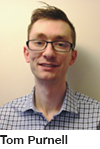Our interviewee for this instalment of People in NDE is Tom Purnell, an employee with Rolls-Royce  Nuclear Field Services, who has inspected an impressive array of objects during his NDE career…
Nuclear Field Services, who has inspected an impressive array of objects during his NDE career…
Briefly describe your current role in NDE.
I work for Rolls-Royce and have the responsibility for sales in the Nuclear Field Services Business, which provides specialist services to nuclear sites and operators. The majority of work that we undertake relates to inspection solutions, both visual and NDT, with a significant portion of this being novel techniques. The most significant part of my role involves speaking with the customer to understand their needs and supporting the business to find a solution and obtain a contract to allow us to deliver the work.
What does a typical work day involve? Or is there no ‘typical day’?
It could range from arranging contract cover for NDT training to liaising with the customer and discussing novel NDE techniques on multi-million pound critical projects to ensure continued power generation.
Why did you choose NDE?
My first role in the sector was with Olympus as a territory manager, selling NDT and remote visual inspection equipment. I worked there for a number of years and I really valued this time – Olympus is a great company and the role took me to every sector, from Formula 1 to the Royal Air Force and even museums, where, on one occasion, I inspected an Egyptian sarcophagus! It was this experience that has kept me in the field of NDE.
What education/training route did you follow?
I studied Engineering and Business Management at the University of Warwick, which gave me a great start, but the learning really started with my first job. After a placement with Rolls-Royce, I then worked for a number of smaller companies, which was really valuable as it threw me in at the deep end and helped me to learn quickly before moving to Olympus and then to my current role at Rolls-Royce.
What would you consider to be your biggest achievements and challenges to date?
Whilst working for Olympus, I was the account manager for the Ministry of Defence (MoD) and we secured a contract with the Royal Air Force (Defence Equipment & Support) to upgrade the fleet of ultrasonic flaw detectors with the EPOCH 600, which is a great piece of inspection equipment. This was a significant project that ultimately improved the inspection capability of the forces, which I was very proud of.
Do you have any interesting NDE stories to tell? Any career highlights?
Being on the Queen’s plane, viewing huge vaults of gold/silver, working with Formula 1 teams, getting in tanks, viewing unreleased cars, visiting nuclear stations and many more are all highlights of my career in the sector.
What changes, if any, do you foresee for NDE in the future?
Every day I see a shortage of professionals in this sector and bringing new blood in has to be a priority for us. I only began to realise what NDE was and its impact when I took the role at Olympus, but it should be an integral part of education for the younger generation in the field of engineering. I know this is something that BINDT is already working on and has already made significant progress with.
NDE is rarely considered a ‘hot topic’ and does not receive much media attention – what do you think about this?
NDE is critical to the quality of all aspects of manufacturing and many services, including forensics. The impact of NDT is rarely recognised and ultimately saves lives through the early indication of defects.
How would you describe NDE/NDT to someone who knows little or nothing about it?
NDE means that when I go on holiday in a plane I feel safe. It ensures that manufacturing, engineering and services have the appropriate levels of quality and inspection, either by confirming that an item is fit for service or by providing an early identification of defects, which can then be investigated.
What is your favourite NDE technique and why?
I always found resonance inspection of multi-material, multi-layer structures very interesting, including the all too frequent challenge of obtaining suitable reference standards.
And, finally, if you could inspect any structure/component, what would it be?
I was lucky enough to inspect the mast of HMS Victory, which was a great opportunity, and I look forward to being involved with nuclear new build at Hinkley Point C.
Please get in touch if you have any recommendations for future interviewees or would like to be interviewed yourself. Contact the editor at ndtnews@bindt.org or email Maria Felice direct at mvfelice@gmail.com
 Nuclear Field Services, who has inspected an impressive array of objects during his NDE career…
Nuclear Field Services, who has inspected an impressive array of objects during his NDE career…
Comments by members
This forum post has no comments, be the first to leave a comment.